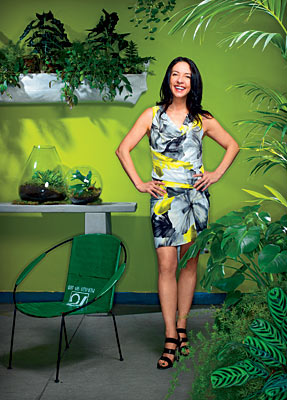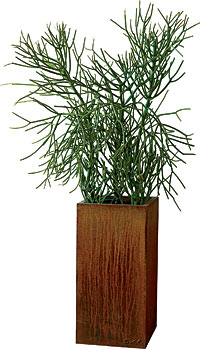
Heibel in the Chicago store with a few elements of surprise, including a chair made with pieces of recycled oil drums ($250) and, hanging on the wall behind her, a soft-sided Wally planter ($49-$188)
For ideas on how to create a modern and inviting outdoor space, we turned to Tara Heibel, owner of the hip urban gardening stores Sprout Home (in Chicago and in Brooklyn) and an all-around groovy gal. (Her Ukrainian Village house will be featured in a forthcoming book from the creators of the Design*Sponge blog, due to land this fall from Artisan Books.)
How do you begin to plan an outdoor area? First, assess the architecture of the space. Are you starting from scratch or is there an existing framework into which you must fit your design? Second, decide how you would like to use the space. Playing? Entertaining? Relaxing? Third, consider how much time you will be able to devote to the space. Plants are like people; they need varying degrees of maintenance. Finally, determine your budget.
Do modern buildings have any special issues when it comes to garden aesthetics? People come to me and say their house feels cold—often because the exterior walls are a grayish brick or stone. In that case, I recommend using teak or cedar containers and some colored pots to warm things up.
Are you a fan of colorful containers? My taste is minimalist. When it comes to color, I tend to use only one, in different tones, so it doesn’t feel like a circus. When people have a bunch of different colored pots, I suggest putting them against a backdrop of natural-colored fiber-cement containers filled with leafy plants.
What do we need to know about containers? When people buy containers to plant big trees and the trees don’t survive the first winter, they are very disappointed. The problem is they are not over-wintering, or insulating, their containers properly. You have to fool your trees and shrubs into thinking that they are in the ground.
What containers do you recommend for large plantings that stay outside year-round? The ones that best tolerate our climate are made of steel, aluminum, fiber-cement, and heavy-duty poly-molded plastic. Terra cotta and other ceramic pots can crack in cold temperatures. Use those for annuals, then empty and store them or turn them upside down at the end of each season. The beauty of non-built-in containers is that if you know you will be moving soon, you can move them with you.
Any tips for stretching a budget? You can cut down your seasonal expenses by planting shrubs, trees, and perennials rather than annuals. Even if a tree costs $100, it’s a good deal—it should last forever, while if you are buying annuals you can easily spend more than that each season. If you do want annuals, remember that the more mature the plant, the more you pay for it. Starting from seed is the low-cost route.
What are some plants that make a statement and don’t require constant upkeep? There are so many low-maintenance plants out there—some of my favorites are sedum and carex grass. One thing to remember: When you are told that a plant is drought-tolerant, that usually means it will be that way after getting established. You need to nurture the plants until then, which can take a full season.
Photograph: Bob Coscarelli

For warming up modern architecture, Heibel recommends patinaed iron containers. Shown here, a pencil cactus ($39) in a container that is 29 inches high, 12 inches square ($208), at Sprout Home.
How do you make the most of plants’ sensory qualities? Plants can evoke emotions and reinforce the intended use of a space. Blades of miscanthus grass rustle in the wind and create calm, while lavender creates calm through its aroma; both are great for an area meant for relaxation. Alliums dancing in a perennial bed are playful—they’re like big balls on sticks and kids love them. I like them in mass plantings. If elegant late-night dining is a regular occurrence on your deck, white flowers with glossy leaves, like gardenias, are fragrant and catch the moon and candlelight, adding brightness and dimension. Or try the simple but amazing night-blooming moonflower (Ipomoea alba), which perfumes warm summer nights.
What about furnishings—what is your approach? If possible, I like to use vintage outdoor furniture. I prefer late 1960s and ’70s pieces. At home I have a vintage yellow powder-coated steel table and chair set with orange vinyl cushions. But if you have a Room & Board table, you can add vintage chairs, or simply more interesting chairs that really stand out. Lucite is also great for chairs and side tables.
What’s your take on accessories? I can always incorporate a functional accessory, such as a bench, into a design, but whimsical things like garden animals tend to get lost. If someone had a few stone animals, I might do something eccentric like paint them all hot pink and put them in different spots around the yard.
What if you have a small deck or courtyard-like space? Don’t forget about your walls and ceilings. Not everything has to be in a pot on the ground. A lot of our more modern-leaning customers are buying Wally pockets, soft-sided containers with waterproof linings that you can hang on a wall or fence and fill with trailing plants, like ferns. They look great paired with Sky Planters, which have a locking disc that holds soil in place and allows plants to hang upside down. Also think about varying the heights of your planters and plants—this will force the eye to move around the space and make it appear larger. Rectangular containers maximize space on a smaller deck.
What if you have a large deck? Break it up and create various rooms and seating areas by using different depths of planted-up containers. Create a dining area closer to the kitchen and around some bends have various seating areas—maybe one with two loungers and a small table, another with four chairs, or two ottomans. If you stand at one corner of it, you wouldn’t necessarily know what is on the other corner without taking the trip. We once designed a deck for a client who used it purely for cocktail parties. So we created a path, bordered with containers, that branched off into little congregating spots, with plants surrounding every seating area on at least two sides, for intimacy.
Do you prefer leafy plants or flowers? For me, foliage is always the main star. It is important to remember that a flower will have a specific bloom time and will not be there the entire season like the foliage will. I like a minimalist setting, so I tend to mass leafy plants to create an even consistency, and then add a few flowering plants, spaced and timed according to when they bloom.
What are your favorite flower-foliage combinations? For a minimalist look with tropical overtones, I like black elephant’s ear with Japanese sweetflag and black and blue salvia; I would have the big black elephant-ear leaves rise above a mass of bright-green sweetflag grass, and use the tall blue salvia to soften the lines. Chocolate mint coleus with foxtail fern and a mix of gazanias make for a fun, almost circus-like effect without going overboard. This particular coleus has burgundy leaves with green edges—mimicking the dark ring around the center of the gazania flower; I would surround them with bunches of foxtail fern, which have a comical, wagging-tail-like quality. White gardens can take on an ethereal glow and be quite sexy, which is why I like hakuro nishiki variegated willow with lamb’s ear and jasmine. The whites, pale pinks, and silvers that appear in these are fabulous in front of darker buildings.
What other elements do you tend to return to? I love using tropical bamboos to create a perimeter around a space. You can also use a multi-trunk birch tree to anchor a space or block an eyesore.
Any suggestions for walkways or house entrances? I recommend flanking an entryway with matching containers and larger plants, and then on each side accessorizing with smaller plants that don’t necessarily match, but go together. A good analogy would be that you dress up your basic black dress with a chunky gold necklace, whereas your twin sister wearing the same dress opts for flat bamboo bangles.
Is there anything every outdoor space ought to have? Yes! Surprise.
CONTACT SPROUT HOME, 745 N. DAMEN AVE., 312-226-5950, SPROUTHOME.COM
Photograph: Bob Coscarelli
Related:



